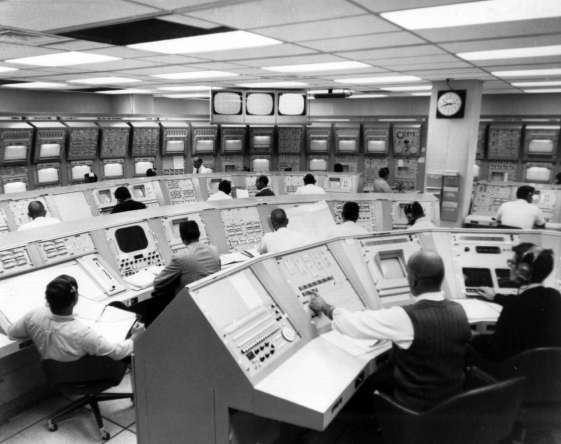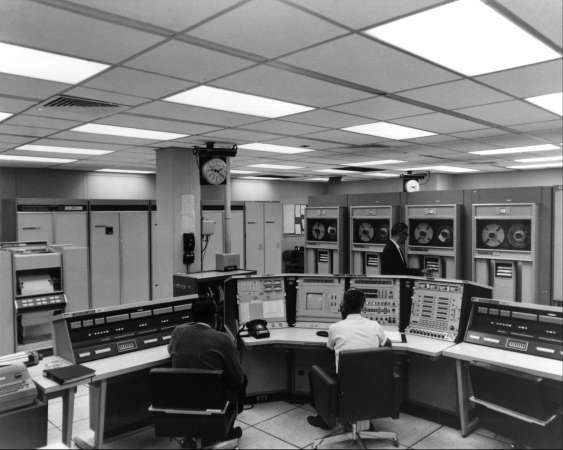
Spacecraft Checkout

An operation under way in the automatic checkout equipment (ACE) control room, February 1967.
ACE's first major test at KSC came with the checkout of Apollo 009 (AS-201 mission) in late 1965. The spacecraft team directed the checkout from a control room in the operations and checkout building. Engineers from Spacecraft Operations and North American, working in pairs, tested the nine functional systems: communications, instrumentation, service propulsion and reaction control, stabilization and control, guidance and navigation, power and sequence, fuel cell and cryogenics, aeromedical and astronaut communications, and environmental control. Commands were initiated at the test consoles, e.g., an engineer might test the freon level in the command module's environmental control system. His signal went to the command computer for conversion to a binary instruction. The digital message traveled a complicated electrical path to the spacecraft, where it triggered a sensor in the command module. The sensor noted the condition of the freon and transmitted an appropriate response. Data acquisition equipment routed the signal back to a display computer, which processed the message for presentation on the same test console whence the command had come seconds earlier. Command and display computers and much of the data acquisition and recording equipment were located in an ACE computer room.39

Automatic checkout equipment room, February 1967.
Three different groups of sensors obtained data concerning the Apollo spacecraft: ground service equipment, carry-on equipment that was removed prior to flight, and sensors built into the spacecraft. Coaxial cable and radio connected the various sensors to the control rooms in the operations and checkout building. There, data traveled through one of three different paths. The most important, from the standpoint of real-time display, was the display computer. Its functions included: comparing machine words to determine whether data fell within predetermined limits, converting data into engineering units (such as heat rise in degrees per second), and generating signals that would produce alphanumeric displays on consoles. The display system was impressive but not foolproof. An engineer recalls that on its first day of operation, the console welcomed them: "GOOD MORING." ACE had failed its first spelling test.40
During lunar missions, four control rooms would be used for spacecraft checkout: primary and backup rooms for the command and service modules and another pair for the lunar module. Each room had 20 master consoles and additional slave consoles. The latter displayed the same data shown on a master, but did not provide the means to select information. Nine TV monitors carried pictures from portable cameras located around the spacecraft. The overhead monitors were part of an operational TV network that carried spacecraft and launch vehicle pictures to the launch control center and central instrumentation facility, as well as the operations and checkout building. Although the equipment had a similar appearance, configurations differed, depending on the requirements of particular systems. During checkout, between 40 and 50 men occupied each of the primary control rooms. In the backup rooms, the consoles were kept in operation but usually were not manned. Each control room was supported by a computer room with its uplink and downlink equipment.41
| Next |